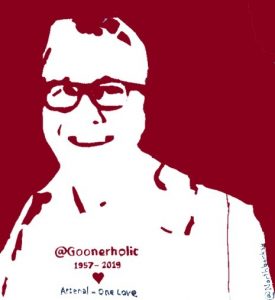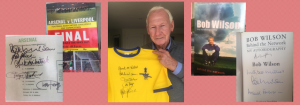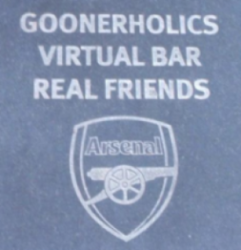I take such pleasure from Dr F.’s literary contributions to this fine establishment that when he suggested during the World Cup that I pen a monograph on Herbert Chapman for this interlull, it would have been ungenerous to decline. So, with the editor’s indulgence, here goes.
Herbert Chapman was our first great manager. I will go further. He was the first great manager of any club and our greatest manager. Only Arsene Wenger approaches him in our pantheon, although Mikel Arteta, who has uncanny echoes of Chapman, may one day join them.
In his book on the evolution of the manager, a role as we understand it today, that Chapman created, Barney Ronay describes him as arriving from the future. What he brought with him was the warp and weft of the game decades hence.
Among Chapman’s innovations:
- shirt numbers;
- white balls and hooped socks for better visibility;
- the white sleeves on our shirts;
- tactics;
- floodlights;
- club branding (Gillespie Road Tube station renamed Arsenal);
- picking the team;
- rubber studs;
- physical conditioning;
- player nutrition;
- European matches and learning from great continental coaches like his friend Hugo Meisl (the FA frowned on that; bad form mixing with Johnny Foreigner, old boy).
The list goes on and on.
Arsene Wenger could be considered another time traveller who revolutionised how the game would be played and managed. But even in arriving from the future, Chapman was first.
North to South
Like many outstanding managers, Chapman’s playing career was modest, a journeyman forward as the 19th century became the 20th. Eventually, he washed up at some Southern League club in the Middlesex marshes. Always in the shadow of two more successful footballing brothers and approaching his 30th birthday, Chapman decided in 1907 that it was time to pursue the engineering career for which he had studied.
Instead, a twist of fate saw him appointed player-manager at Northampton Town, a former club in the Southern League. A growing reputation as an innovative coach — and success — brought a move to Leeds City in the old Division 2 in 1912, where some sketchy allegations of war-time financial impropriety by the club resulted in a lifetime ban from football. After resigning from Leeds in 1919, he supervised a coal and coke works but was laid off at the end of 1920. A month later, Huddersfield Town, having made the ban go away, appointed Chapman ‘secretary’ as managers then were often called in a fair reflection of the nature of their job.
In May 1925, Arsenal posted an advertisement in the Athletic News:
Arsenal Football Club is open to receive applications for the position of TEAM MANAGER. He must be experienced and possess the highest qualifications for the post, both as to ability and personal character. Gentlemen whose sole ability to build up a good side depends on the payment of heavy and exorbitant transfer fees need not apply.
The outgoing manager Leslie Knighton had spent exorbitantly but to poor effect (sound familiar?). Arsenal finished two places off relegation in 1923-24 and one place off in 1924-25. With Chapman having buffed up his CV with an FA Cup and two successive Division One titles, Arsenal’s chairman Sir Henry Norris was so determined to secure him that he doubled Chapman’s Huddersfield salary and bought him a detached house in Hendon, then a leafier outer suburb of London than now.
An English Heritage Blue Plaque adorns the red and white painted house at 6 Haslemere Avenue, east of the A41 from the Brent Cross shopping centre. Another first: no one connected with football had previously been so honoured.
Chaos to control
Chapman arrived to find a club in chaos on and off the pitch (again, sound familiar?). A return to Division 2 looked increasingly likely, while financial problems were undermining the long-dominant Sir Henry.
Chapman seized the opportunity. He would pick the team (previously the chairman’s or directors’ prerogative), set the tactics (typically a task, such as it was, of senior players), and decide who would be bought to fit his unconventional way of playing.
Arsenal was what we now call a project, and there was no doubt about who was the project manager. Chapman was charismatic, a great motivator and held his players in thrall, but he was a firm disciplinarian. Woe betide anyone that did not buy into his plan (yet again, sound familiar?).
WM
Chapman applied his engineer’s mind to the scoring of goals. He believed these could be reliably manufactured with teamwork, discipline and organisation.
He did not invent the concept of the centre half dropping between the full backs; many teams experimented with that in response to a new offside law. Yet, he alone saw how to exploit the space this created in midfield by changing how wing halves and inside forwards played. He systemised this as the WM formation, converting the ubiquitous 2-3-5 pyramid into the 3-2-2-3 that every English team would play until 4-2-4 took hold in the late 1950s.
WM was designed to space players around the pitch and retain possession through quick passing (‘combination play’), creating gaps through which his forwards could counterattack at speed.
It was a tactical revolution and a prototype of Arteta’s positional play. Take a still image of Arsenal when Zinchenko moves into midfield alongside Partey with Xhaka and Ødegaard ahead, Saka and Martinelli out wide up front and Jesús in the middle, and you can trace a perfect W and a perfect M on it.
Then as now, the rapid passing and movement the formation demanded required fit players. Trainer Tom Whittaker was critical. Not the typical bucket and sponge man of the day, but a qualified physiotherapist, he introduced physical conditioning science to the game. If you think Bukayo Saka has bulked up, you should have seen what Whittaker did to transform a reedy vegetarian ex-milkman, Eddie Hapgood, into a strapping full back at about the same age.
5-year Plan
The project engineer also had a five-year plan to rebuild the team.
His first addition was veteran Sunderland centre-forward Charlie Buchan. Plumstead-born and an amateur with Woolwich Arsenal’s reserves in his teen years, Buchan was acquired to be Chapman’s right-hand man as captain and, like newly bought Joe Hulme and Jack Lambert, to bolster an attack that had scored just 86 league goals in its previous 84 league games.
Chapman also had an eye for raw talent, such as Cliff ‘Boy’ Bastin, spotted as a 17-year-old playing for Exeter. Bastin is still the youngest player, at 19, to have won a league title, the FA Cup and an England cap. Chapman made Bastin the perfection of another of his innovations, the inverted winger, a fast, direct forward who cut in from wide and scored goals (think Martinelli or Bobby Pires, but better looking). It was Bastin’s club record of 178 goals that Ian Wright broke.
Hapgood and George Male, both fixtures in the Arsenal and England sides in the 1930s, were two other future greats signed as teenagers. But Chapman spent on stars how and when needed. He made David Jack the first five-figure signing in world football at £10,647 10s 0d (Google the old money, younger ‘holics). For his Martin Ødegaard-like orchestrator, Alex James, Chapman arranged a ‘job’ at Selfridges department store to supplement the maximum wages the club could officially pay him.
In Chapman’s first season in charge, Arsenal finished second behind Huddersfield winning its third successive title. The rebuilt attack doubled goal production. The defence, little changed, was as porous as before. Yet more goals scored than conceded brought wins (funny that!).
The defence would not start to be rebuilt until the 1929-30 season when the Eddie Hapgood-Herbie Roberts-George Male back three was first put together. Before that, there had been three seasons of mid-table finishes, although also a first FA Cup final — the infamous loss to Cardiff City in 1927.
But in 1930, in line with the five-year plan, Arsenal won its first major trophy, the FA Cup. The first league title followed in 1930-31, and another in 1932–3. In the intervening season, we did the ‘almost’ double — second in the league and beaten FA Cup finalist. Chapman had made Arsenal the dominant team in England.
He had also made Highbury the finest stadium in England, building the West Stand to keep fans dry and coming to games in all weathers — Arsenal needed gates of 40,000 to break even — and the marbled East Stand to overawe opponents. Even the famous clock was his idea and a rebuff to the FA for preventing him from installing a 45-minute countdown clock that, ever the showman, he thought would add to the excitement of watching games.
Dynastic greatness
Chapman died unexpectedly in January 1934 in his Hendon home after developing pneumonia following a scouting trip up North. He was fifty-five and at the height of his powers. He died with his team en route to a third title in four years, secured under reserve team coach Joe Shaw, who became caretaker manager for the remainder of the season.
To me, what makes Chapman our greatest manager is that he was dynastic. He was succeeded by the club’s managing director, George Allison, and then Whittaker. By the time Whittaker died of a heart attack in 1956, Arsenal had won another five league titles and two more FA Cups, all won by identifiably ‘Chapman teams’. How many more might there have been had World War 2 not stopped football for seven seasons with the team in its pomp?
Chapman stares back at us from grainy black and white photographs from 80 years ago, portly, suited and serious, looking more like the successful owner of an early 20th-century Northern engineering works than the first coming of the modern manager. But look again, and you will see the spirit and soul of the club we are today.








ned, wonderful piece. he was brilliant, and i think set arsenal on a path that, even in lean years, we haven’t deviated from. your view of arsene as from the future later is as apt as chapman being the first to come back, or the first to see that far ahead. i love that we can see the WM in arteta’s zone vision, and in the play of our backline (ben white in particular, though zinny’s ability to be everywhere all at once should earn him an oscar as well, and is probably more deserving).
Brilliant Ned !
I used to tell Dave he should bring out a book of his historical pieces and I think you might well do the same.
Lots of this relates to nearly a hundred years ago but you have brought it superbly back to life. 👏🏻👏🏻👏🏻
Thank you Ned! I was eagerly looking forward to this piece from you, and this was worth the wait. I will share it around widely. Completely agree with the “The first great manager and our greatest manager.” TTG had mentioned the thread of excellence— and might I add innovation and inclusivity to that — that runs through this club and much of that originated from Chapman’s visionary ideas.
I also loved the fact that you talked about his friendship with Hugo Meisl. I started reading about that and the Meisl brothers earlier.
As you mentioned, the WM remains a singularly pioneering moment in football’s history of great tactical innovations as for the first time a structured and methodical spatial awareness was used as one of the fundamental principles to build the footballing style on.
Thank you again!
Ned,
For obvious reasons I have a huge interest in Chapman and you have captured the essence of his life and achievements superbly, many thanks . I grew up on stories of that 30s team and as a young lad I often got into conversations at Highbury with older supporters who bemoaned the current state of the club and harked back to Chapman’s days .
He literally transformed our club from a relocated South London team of minimal achievement into the finest and most powerful club in football in ten years.
I met Ted Drake at a lunch in 1991 and even nearly sixty years on his eyes sparkled with joy at the recollection of being part of that journey and working in those times .
Wenger was massively transformational too and Arteta shows all the signs of being the same but without Chapman they would have had little to transform . One of the great figures in the history of English football .
Great work Ned
I thoroughly enjoyed that article, Ned. Thanks so much for taking the time to write it.
Thanks, Ned. You are a bringer of history to life, and a proud history it is. A drink lifted to Herbert Chapman.
Thanks Ned, an enjoyable read!
And timely with our new Chappers about to win his first title.
That’s a superb summary of Herbert Chapman’s role in Arsenal’s history, Ned. Thanks for a great read.
Chapman is an iconic figure whose personal drive made Arsenal one of the great clubs in England and the biggest club in London. Without Chapman’s contribution, as others have rightly observed, his successors as manager, right down to MA8 would have struggled to achieve what they have. Chapman’s contribution demonstrates the importance of having a strong leader with vision at the helm of a club. We were fortunate to have another visionary in Arsene Wenger whose two phases of initial huge success, followed by years of frustration demonstrate that drive and vision are not enough to achieve success but there is a necessity for the right chemistry behind the scenes. I am optimistic that the club now has the right chemistry and the current incumbent has the drive and vision to succeed.
Thanks Ned for a wonderful synopsis of an iconic figure. I have several books on Herbert on my shelves, including Herbert Chapman on football, a fascinating collection of articles he wrote for the Sunday Express in the early 1930s, and Herbert Chapman, the first great manager , an excellent biography by Simon Page. He was the one that turned us into the “ Bank of England” club, and changed the culture to give us the class and history that we are all so proud of. He was taken from his family and the club at the very young age of 54. A fine interlull piece in the great traditions of this blog.
Excellent, Ned. Informative and entertaining.
I am pleased to observe that the Arsenal Women demolished the Tottnumb Scrubbers by a score of 5-1. I understand that it’s difficult to assess the quality of that victory though as apparently Tottnumb get battered everywhere they go! 🤣
Ahem
I watched the ladies game and it was a severe thrashing. Tottnumb certainly got battered at Brisbane Road. The ladies have revived after losing Miedema and Mead . The young winger Palova is very talented and Blackstenius got a very sharp opening goal.
Tottnumb are making the same sorry fist of women’s football that they are of men’s. They’ve just sacked their manager and looked a couple of classes below Arsenal who could sub off some of their stars before their CL second leg with Bayern Munich on Wednesday
ESR played for the England U21s in a friendly against France. 60+ minutes and a goal. Hopefully this gets his season going.
I guess that’s Englands way of letting ESR know he isn’t forgotten.
Be fantastic if he, Bukayo and Eddie can get us a few goals from Hale End
over the last 10 games.
Thanks Ned,
A top, top piece.
UTA.
Cheers Ned, that was a very enjoyable and informative read – it filled in many gaps in my knowledge of the great man.
Sadly the TTG house has been hit by Covid 19.Looking for sources of cheer I saw this
“Arsenal’s men’s and women’s sides have won all four of their league games against Tottenham this season by a combined score of 14-2.”
Best wishes to everyone TTG, I hope all will be well soon.
North London is very red indeed this season!
Thanks all for the kind words. It was a pleasure re-reading the literature on Chapman. I could offer no new scholarship, but I am glad my attempt to trace a managerial bloodline to Super Mik struck a chord. Again, a tip of the hat to Dr F. for suggesting it.
I expect Ode’s ankle is very red too, where Rodri tried to kick it off.
I was amazed that wasn’t a penalty. And glad Ode seems fine.
TTG@18: Here’s to a speedy and full recovery.
Cheers Ned. Splendid piece.
Get well soon TTG and and the same prescription to the lady of the manor. 👍🏼
Seeing as it was reported that the Arsenal women completely dominated Spurs in their 5-1 demolition of them the other day, a grammatical issue sprung to mind. Is it more correct to call them the dominatrices or the dominatrixes? Answers on a postcard, please.
BT8, the plural of dominatrix is indeed dominatrices.
An interesting insight into how you spend your leisure time?
And TTG, get well soon.
Quite possibly so, CER but I have always been told to be careful what to wish for. 🫣
Get well soon, TTG and household.
Best wishes to both. 🍷
Hope you can still smell the bouquet!
Another manager has gone by the boards at Sp**s and here’s what the noisy neighbours are saying about it. I post it as it’s good for at least one hearty belly larff.
https://cartilagefreecaptain.sbnation.com/2023/3/26/23648951/tottenham-hotspur-news-antonio-conte-sacked-daniel-levy
If Conte couldn’t make anything of the neighbours, I doubt anyone can.
Bukayo Saka has now played as many Premier League games for Arsenal as Jack Wilshere (125)?
C100@31: The numbers show that Saka has 125 Premier League appearances to date (with 113 starts) but Jack had 182 appearances (with 133 starts).
Ned. The key stat there is for Arsenal. Jack also played for other clubs.
Thanks bt8 @29. Always loved that Mel Brooks line.
@30 agree Ned, Maureen was a has been and Poch a never was but Conte actually won stuff and I was a bit worried. Anyway, they spursed it up as usual so alls well that ends well.
Thanks for your good wishes everyone
I’ve been vigilant in keeping Mrs TTG away from the virus over the last three years but a trip to Camden Market did for her and I’ve picked it up subsequently ( my second dose )
It’s like a very heavy cold but we were due to have a long planned post- Covid reunion in Derbyshire this weekend which is now in jeopardy from our perspective . Despite the rules I’m reluctant to mix socially while still testing positive so I hope that second red line disappears for both of us soon
C100@33: I had completely read over the condition. My bad. It is 125 games a piece in red and white, and Saka is well ahead of Jack in starts, 113 to 92.
The monks can make up for their error Ned by determining the most consecutive matches that LJW ever started for the club. My guess is that he has long been surpassed on that front by Bukayo.
For anybody still slightly confused about WTF happened at the Tottenham.
https://www.theguardian.com/football/video/2023/mar/26/whats-went-wrong-for-antonio-conte-at-tottenham-video-explainer
Thanks Ned! Excellent, informative and very enjoyable read about the first time traveller.
Attracting geniuses from the future is an Arsenal speciality.
COYG
The PL “net spend table” since Conte took over at Spurs shows Arsenal spent the 7th most of the current 20 clubs, and Spurs the 5th most.
https://www.planetfootball.com/quick-reads/antonio-conte-net-spend-table-premier-league-tottenham-arsenal-chelsea/
Money spent more wisely by some than by others.
Chelsea spent by far and away the most as you might have guessed.
The Wolves sales for Silver ended in failure. I half-expected that, but it’s really a bit mental. Announced sold out at 10.05, reckon there was probably a two or three minutes window max when joining the queue would have yielded results, and I wasn’t into that window.
It was pretty much the definition of a lottery.
It wasn’t a lottery, Ollie. In a lottery everyone who wants to take part has an equal chance. This was a scrum. There appears to be a 1 in 20 chance of a ticket now for a Silver Member but it’s less than that because success is about hitting the queue at the moment the gate opens, which appeared to be before 9.10 am this morning. The club need to sort this out or to stop extracting £60 for the privilege of such frustration and failure. I find it extremely alienating and recognise that I probably now need to go elsewhere to watch live football.
>>>>>>>